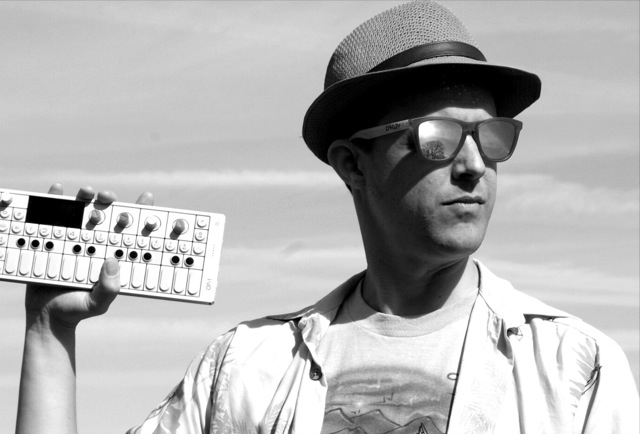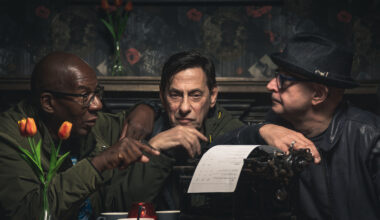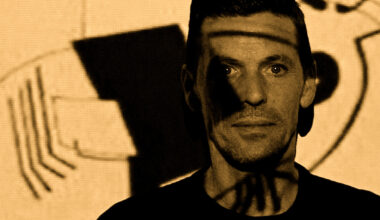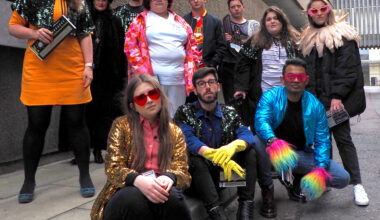Our esteemed Tech section kit reviewer Luke Sanger doesn’t just talk the talk, he walks the walk as techno producer Luke’s Anger. We hitch a ride with him for a weekend in Poland to discover how he cuts his one-man rug live…
The solo live show? Traditionally the preserve of our guitar-wielding friends, the rise and rise of increasingly portable electronic kit means that artists such as Luke’s Anger, aka top techno producer, Bonus Round label boss and Electronic Sound tech reviewer Luke Sanger, are increasingly in demand on the live music circuit.
So how do you get to the point where people are describing your sound as “wonkier than a table with three legs and grimier than an army truck” and you’re being snapped up by promoters to play to crowds across Europe on a regular basis?
Luke Sanger’s tale began when he was a teenager, cutting his teeth playing guitar in bands at school. A friend’s cousin was half of Nottingham-based rave duo Nebula II and he’d knock acid house and hardcore mixtapes in their direction. Wasn’t long before Luke was wondering how the tapes were put together and, his guitar duly sold, he bought a pair of cheap decks and a mixer and began to find out.
By the mid-1990s, he was good enough to secure a regular Sunday night chill-out gig at a pub in his home city of Norwich. From there, he quickly found himself playing outdoor parties and raves across East Anglia, before hooking up with a few like-minded DJs to form the Molotov Sound System.
After procuring their own rig from a new-fangled website called eBay, Luke and his pals were soon travelling further afield. When they were playing parties in and around London, they noticed that other sound systems were increasingly shoving samplers, sequencers and drum machines through their speakers rather than decks. So the Molotov boys began scouring the second-hand stores, picking up bits and pieces of kit, and started playing sets revolving around jams pre-recorded on MiniDisc and lots of mucking about.
Reaching university age, the Molotov crew headed in various directions to study. Luke and fellow Norwich DJ Alec Storey went to Bristol. Luke took an Access To Music course, then studied Creative Music Technology at Bath Spa University. But before his first year at Bath was out, his work caught the ear of Jerome Hill from maverick techno label Don’t Recordings, who released the debut Luke’s Anger record, the ‘Fistful Of Donkeys’ 12-inch, in 2006. Alec Storey did alright too, recording as Al Tourettes and Second Storey, as well as being half of Also, who recently put out an album on R&S.
“Two of us from the Molotov Sound System have gone on to make music as a career,” says Luke. “And a couple of the other guys are still DJing, so it was the beginning of something pretty successful.”
Since ‘Fistful Of Donkeys’, Luke Sanger has released three albums and almost 20 singles and EPs as Luke’s Anger. Along the way, he’s earned plenty of praise and maximum respect for his exciting one-man live performances. We discover the ins and outs of playing solo as he heads out to Poland for the weekend to play a show in the northern city of Szczecin.
LANDING THE GIG
“Getting on Don’t Recordings for my first release was really good. For the type of techno I make, it was the go-to label. It probably seems like a small niche of a fairly niche genre, but it does have a wide fan base around Europe. And because there’s a circuit for that type of techno, there tends to be a lot of repeat bookings in places like Prague, Berlin and Dublin, as well as London and Glasgow. On top of that, I’ve played in America, Scandinavia, Russia…
“I have used booking agents, but by far the most common way I get hired is through someone contacting me via Facebook or Soundcloud or an email and then booking me directly. I have set fees for DJing and for live work, but it all depends on the size of the gig. My normal requirements would be flights and a hotel plus the fee. Sometimes promoters say, ‘We can do flights and the fee, but would you mind staying in a spare room in so-and-so’s house?’. It usually works out, but I’ll politely decline if there’s any inkling that I’ll be in the middle of an after-party at so-and-so’s house.
“Antwerp was one of the first European live shows I did, a night called Bomb-O-Matic. I had a pretty good idea of how I wanted to do it. They said they wanted to see loads of equipment, so I took it all in a big suitcase. I remember seeing a picture of Neil Landstrumm’s suitcase after it had been run over by an airport baggage truck, with all his drum machines crushed on the tarmac, so I use Pelican cases now because they’re almost indestructible. You can throw them out of helicopters into shark-infested waters and your gear will stay safe.”
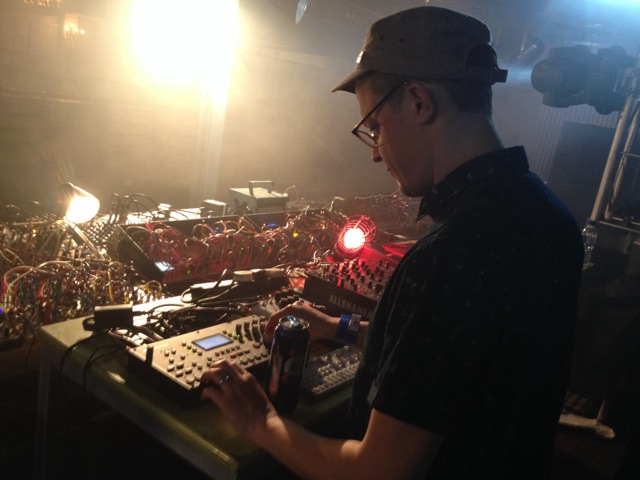
THE LIVE SET-UP
“At the centre of my current live set-up is a Dave Smith Tempest six-voice analogue drum machine, which handles big analogue drum sounds and is an excellent synthesiser too. The voice architecture is based on their Prophet series, so it has a similar character. Next is the Elektron Octatrack, an eight-track sampler which takes large audio files and can do all sorts of effects and mangling on the fly. I use this to trigger loops, audio stems and process/re-sample other equipment via the inputs.
“The strange-looking circuit board with a nine-volt battery is the BugBrand Board Weevil. BugBrand are a UK manufacturer known for their modular synths, but they also make noise gadgets like this one. It’s a drone machine that constantly outputs a mixed, three-oscillator signal. It gets weird quite quickly, as all the oscillators can be synced and FM’d to one another, and is further manipulated by touching the circuit board. It really does sound completely bonkers. It’s always a surprise what comes out of it.
“Finally, the white box is a Rigsmith Dub Siren, a classic effect which I use to add some atmosphere. It has a built-in digital delay and the feedback is crunchy as hell. If you’ve ever been to a dub reggae gig, it’s what makes that bleeping, echoing sound. You just press a button and it’ll bleep, and then it has some knobs to control the echoes and the intensity, which is really fun. It’s built by a guy from Plymouth who also makes sound systems.”
PACKING AND TRAVELLING
“I don’t have a checklist, but I do lay all my kit out before I pack it. I set it all up and have a test to make sure it’s all working, then I unplug everything and pack it, and then the night before I’ll just double-check it’s all there. The Tempest, the Octatrack and cables go into a Peli case, which gets checked in at the airport like a regular suitcase. The other smaller bits go into my carry-on bag along with the rest of my travel stuff.
“Anything I forget to pack can be tricky to replace when I get to another country. I tend to take a couple of EU adapters and a back-up of my Octatrack set on separate flash card. I get stopped at security most times I travel. They always like to have a good look in my hand luggage. I tell them it’s music stuff, but I’ll invariably have to unpack everything and then pack it all back in again.
“I usually listen to podcasts when I’m travelling. I listen to a lot of old Adam And Joe podcasts, I find them quite good for travelling for some reason. In the past, I’ve tried loading up an iPad with films, but I’ve almost always ended up not watching anything. I also often take apps with the intention of getting some ideas out, but again I never really use them.”
SHOWTIME
“There isn’t a keyboard in my gig set-up, so most of my live playing I tend to do by hitting pads rather than keys. The drum machine has pads and you can trigger sounds by hitting those, so I do a bit of that in the set. But the Luke’s Anger stuff uses a lot of samples and is very rhythmical. It’s not really something you’d jam out some chords over the top, it’s more like tweaking.
“From doing raves and parties in my early days, I’ve had my fair share of playing to empty rooms and equipment not working. There’s not much that can go wrong that hasn’t already gone wrong at some point over the years. The biggest problems tend to be logistical rather than technical, things like missing a flight, for instance.
“I had a few tech gremlins during my set in Poland, but mainly it was timing between one piece of equipment and another one, meaning the kit kept losing sync. It sounded a bit like a DJ doing a bad mix. I tend to notice before the audience do, so it’s a quick stop and start and it syncs up again. I’m pretty sure it happened because I was tweaking one bit of equipment too much. Thankfully, catastrophic technical problems are pretty uncommon.”
DOWNTIME
“I still get a buzz about visiting different countries. Travelling on your own can be a bit dull, but I’ll sometimes get booked with someone else and we’ll travel together, which is always a lot more fun. Most of the promoters are really friendly and want to be accommodating, but with language barriers and loud nightclubs, it’s never like you can have a proper conversation.
“I can get quite touristy when I’m away. If there is any chance I’ll have three or four hours spare in a place, then I’ll just walk around the streets. In Poland, I got to see quite a lot of Szczecin on the Sunday, which was really nice. I’ll generally go and have a beer somewhere and try to experience a bit of the culture.
“Most promoters will take you out for a meal and maybe meet up with you the next day to eat. If it’s the first time I’ve been somewhere, I’m always keen to try the local produce. When I went to Russia, the food was strange, very grey looking, but it didn’t taste too bad. It was a cold, lardy, pasta-ish thing and so unlike anything I’d ever eaten before. It did have meat in it, I’m just not sure what kind. The food in Poland was amazing and I always enjoy going to Germany. Sausages and beer!”
